Predictions & Data for this entry
| Model: stx | climate: A, B, C, D | migrate: | phylum: |
| COMPLETE = 3.2 | ecozone: TH, TP, TA, TN | food: bxM, xiO | class: |
| MRE = 0.074 | habitat: 0iTa, 0iTs, 0iTg, 0iFm | gender: Dg | order: |
| SMSE = 0.021 | embryo: Tv | reprod: O | family: |
Zero-variate data
| Data | Observed | Predicted | (RE) | Unit | Description | Reference |
|---|---|---|---|---|---|---|
| tg | 22 | 22.56 | (0.02559) | d | gestation time | Angu1932 |
| tx | 21 | 20.16 | (0.04007) | d | time since birth at weaning | Baye2004 |
| tp | 37 | 39.45 | (0.06612) | d | time since birth at puberty females | GonzLope1984 |
| tp_m | 43.5 | 40.27 | (0.07433) | d | time since birth at puberty males | Baye2005 |
| am | 1400 | 1415 | (0.01045) | d | maximum life span females | Kool2010 |
| Lb | 4.26 | 4.469 | (0.04908) | cm | length at birth | Angu1932 |
| Lx | 11.32 | 13.79 | (0.218) | cm | total length at weaning | NascMuni2014 |
| Li | 27.75 | 26.73 | (0.03665) | cm | ultimate body length | GhezCamb2012 |
| Wwb | 5.82 | 4.804 | (0.1745) | g | wet weight at birth | Baye2004 |
| Wwx | 47.72 | 45.22 | (0.05242) | g | wet weight at weaning | NascMuni2014 |
| Wwp | 123 | 105.3 | (0.1437) | g | wet weight at puberty female | GonzLope1984 |
| Wwi | 330 | 329.5 | (0.001539) | g | ultimate wet weight - females | RoeLee1995 |
| Ri | 0.2301 | 0.1807 | (0.2148) | #/d | maximum reprod rate | Baye2004 |
| Wwi_m | 560 | 542.4 | (0.03135) | g | ultimate wet weight - males | Baye2005 |
Uni- and bivariate data
| Data | Figure | Independent variable | Dependent variable | (RE) | Reference |
|---|---|---|---|---|---|
| tLe1 | 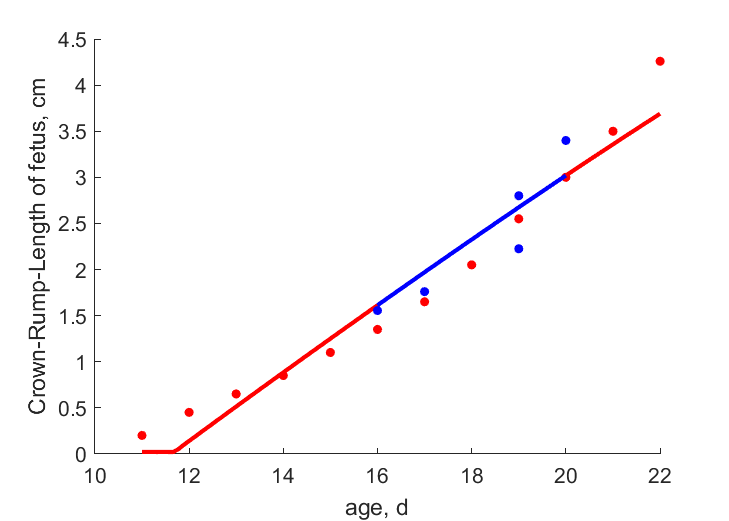 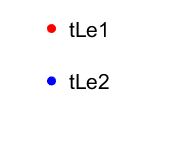 | age | Crown-Rump-Length of fetus | (0.1168) | Angu1932 |
| tLe2 |   | age | Crown-Rump-Length of fetus | (0.1042) | NaraFox1971 |
| tWw_m2598 | 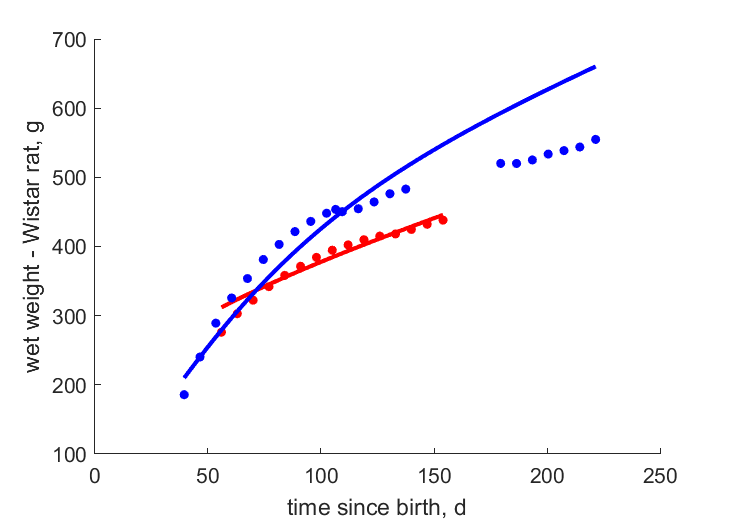  | time since birth | wet weight - Wistar rat | (0.02439) | Baye2004 |
| tWw_m0392 |   | time since birth | wet weight - Wistar rat | (0.09902) | Baye2001 |
| tJX_m2598 | 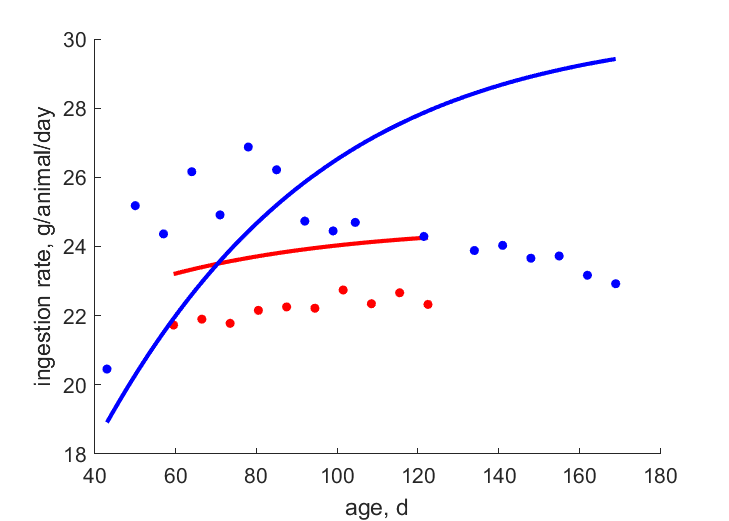 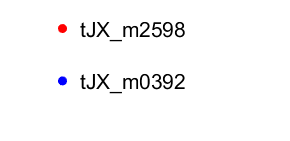 | age | ingestion rate | (0.07315) | Baye2004 |
| tJX_m0392 |   | age | ingestion rate | (0.1425) | Baye2001 |
| tWw_f_np2598 | 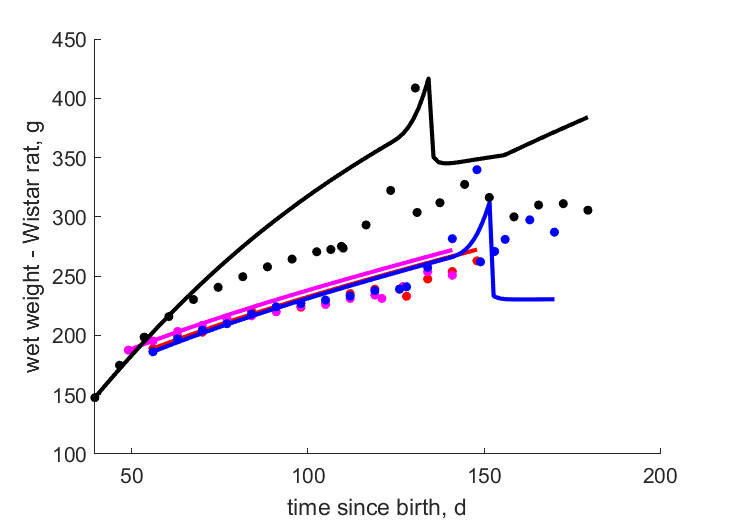 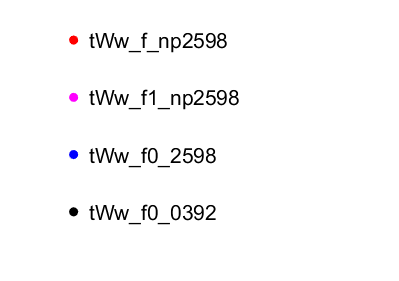 | time since birth | wet weight - Wistar rat | (0.03421) | Baye2004 |
| tWw_f1_np2598 |   | time since birth | wet weight - Wistar rat | (0.04987) | Baye2004 |
| tWw_f0_2598 |   | time since birth | wet weight - Wistar rat | (0.07712) | Baye2004 |
| tWw_f0_0392 |   | time since birth | wet weight - Wistar rat | (0.1392) | Baye2001 |
| tJX_f_np2598 | 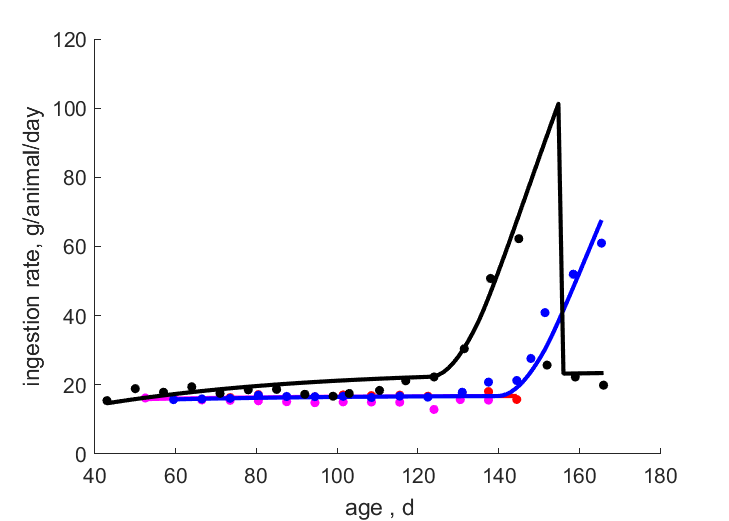 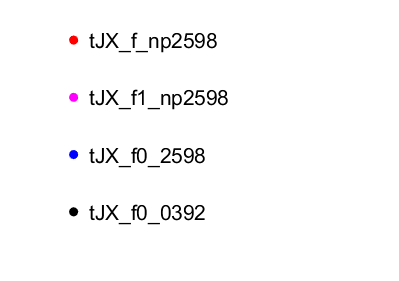 | age | ingestion rate | (0.02808) | Baye2004 |
| tJX_f1_np2598 |   | age | ingestion rate | (0.08436) | Baye2004 |
| tJX_f0_2598 |   | age | ingestion rate | (0.08464) | Baye2004 |
| tJX_f0_0392 |   | age | ingestion rate | (0.2395) | Baye2001 |
| tWw_F0p_2598 | 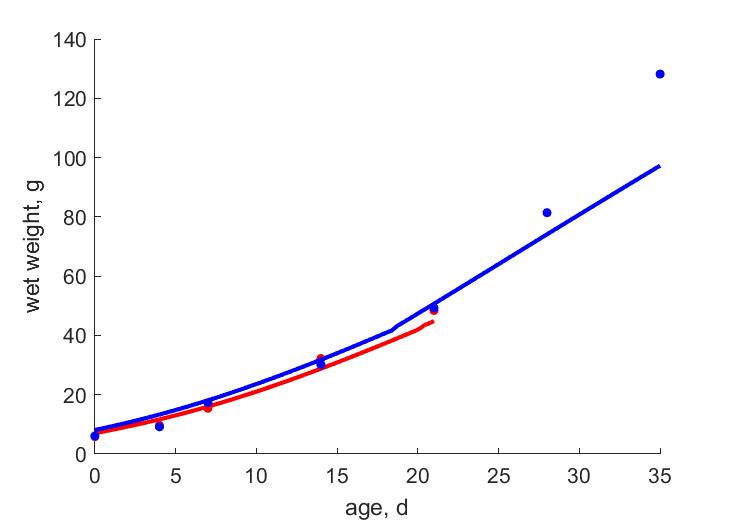  | age | wet weight | (0.09694) | Baye2004 |
| tWw_F0p_0392 |   | age | wet weight | (0.1502) | Baye2001 |
| tWw_C41 | 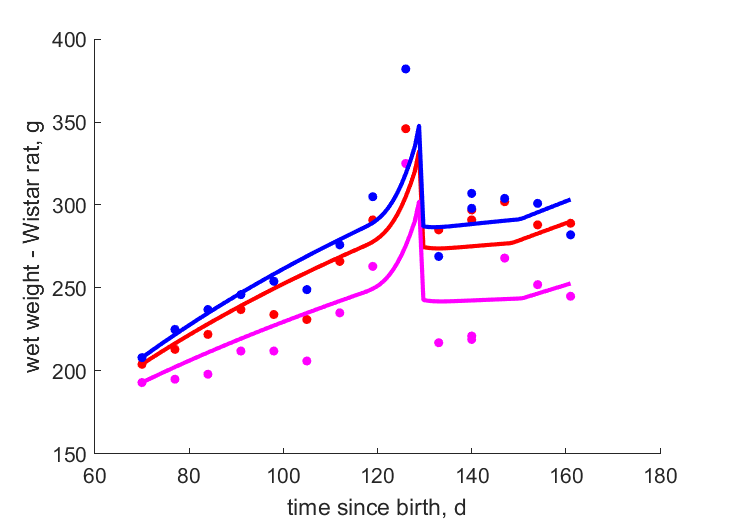 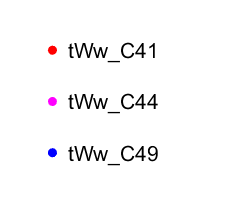 | time since birth | wet weight - Wistar rat | (0.04837) | Baye2002b |
| tWw_C44 |   | time since birth | wet weight - Wistar rat | (0.07219) | Baye2002b |
| tWw_C49 |   | time since birth | wet weight - Wistar rat | (0.04797) | Baye2002b |
| tWw_05study_f | 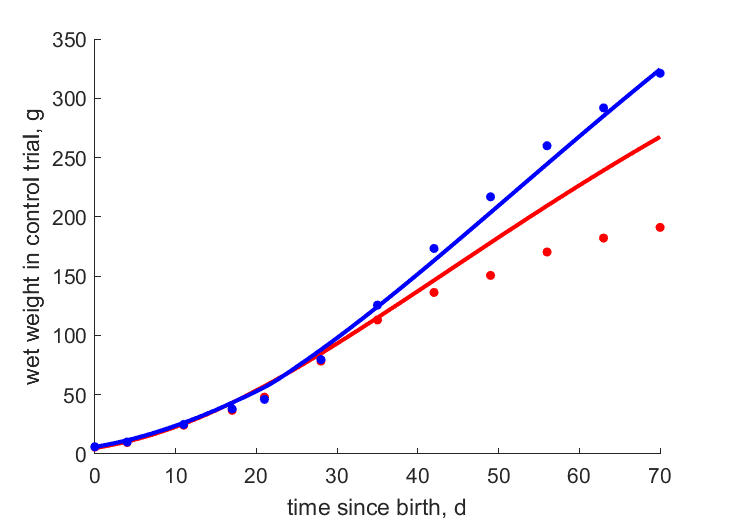 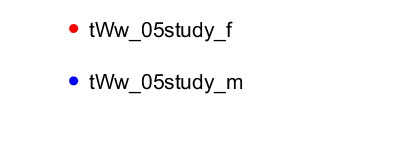 | time since birth | wet weight in control trial | (0.207) | Baye2005 |
| tWw_05study_m |   | time since birth | wet weight in control trial | (0.04835) | Baye2005 |
| WwN_2598 | 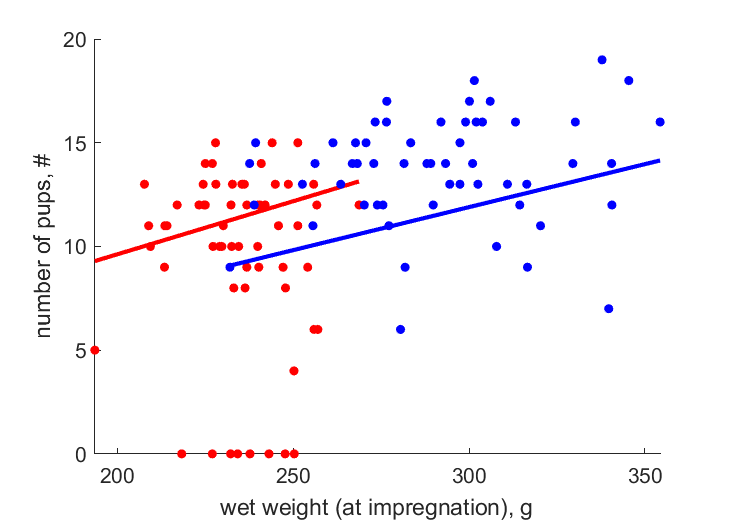 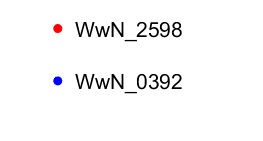 | wet weight (at impregnation) | number of pups | (0.3401) | Baye2004 |
| WwN_0392 |   | wet weight (at impregnation) | number of pups | (0.2162) | Baye2001 |
| tWw_C46 |  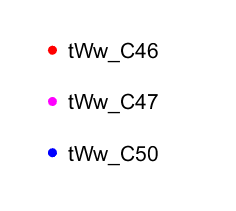 | time since birth | wet weight - Wistar rat | (0.4872) | Baye2002b |
| tWw_C47 |   | time since birth | wet weight - Wistar rat | (0.6609) | Baye2002b |
| tWw_C50 |   | time since birth | wet weight - Wistar rat | (0.8686) | Baye2002b |
| tWw_f0_zhang_ctrl | 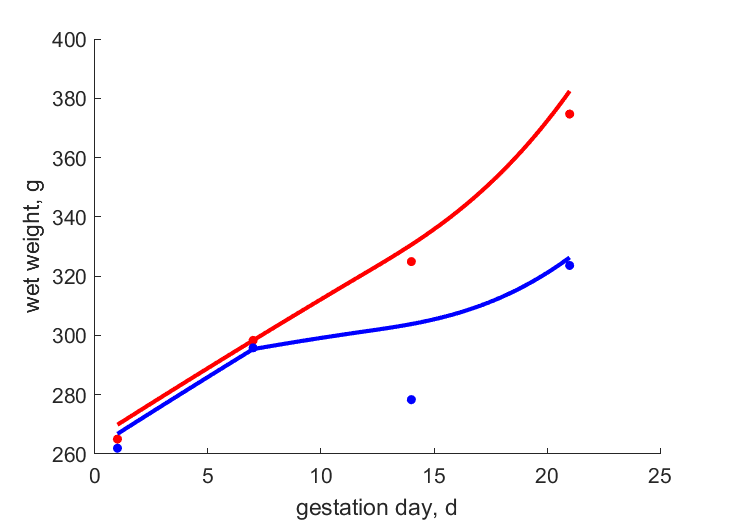  | gestation day | wet weight | (0.01449) | Zhan2010 |
| tWw_f0_zhang_FR50 |   | gestation day | wet weight | (0.02888) | Zhan2010 |
| tWwE_f1_zhang_ctrl | 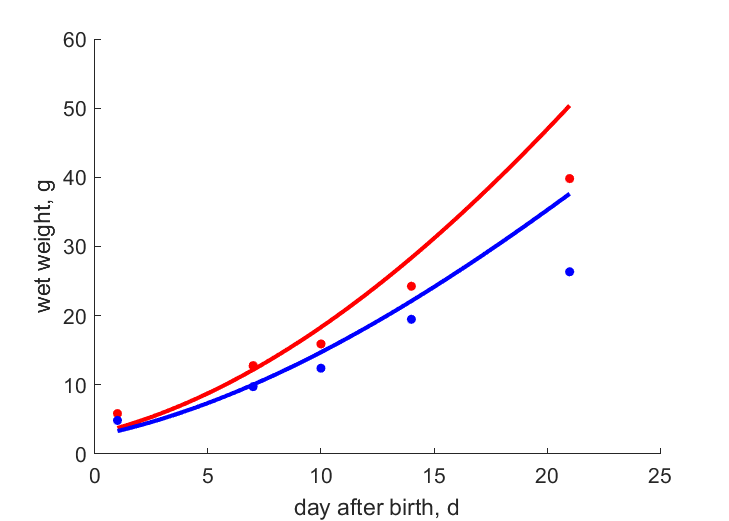  | day after birth | wet weight | (1.003) | Zhan2010 |
| tWwE_f1_zhang_FR50 |   | day after birth | wet weight | (1.241) | Zhan2010 |
| tWw_f0_wood_ctrl |   | gestation day | wet weight | (0.01532) | Wood1996 |
| tWw_f0_wood_30perc |   | gestation day | wet weight | (0.01534) | Wood1996 |
| tWw_f1_wood_f_ctrl | 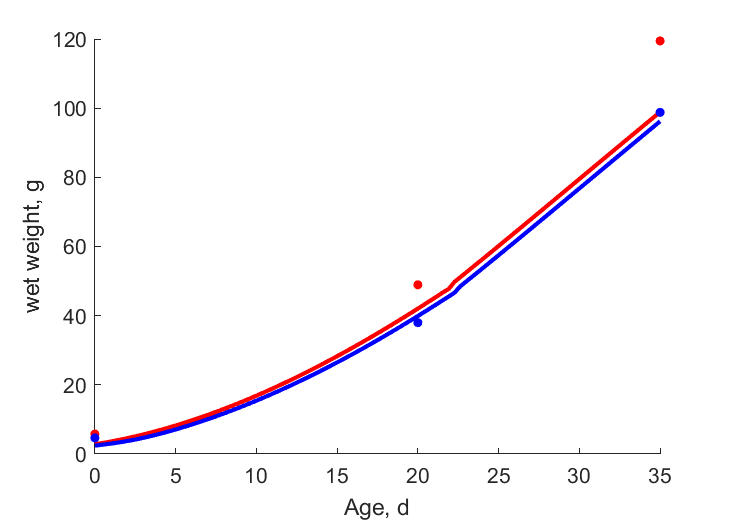  | Age | wet weight | (0.5245) | Wood1996 |
| tWw_f1_wood_f_30perc |   | Age | wet weight | (0.1431) | Wood1996 |
| LWw_f | 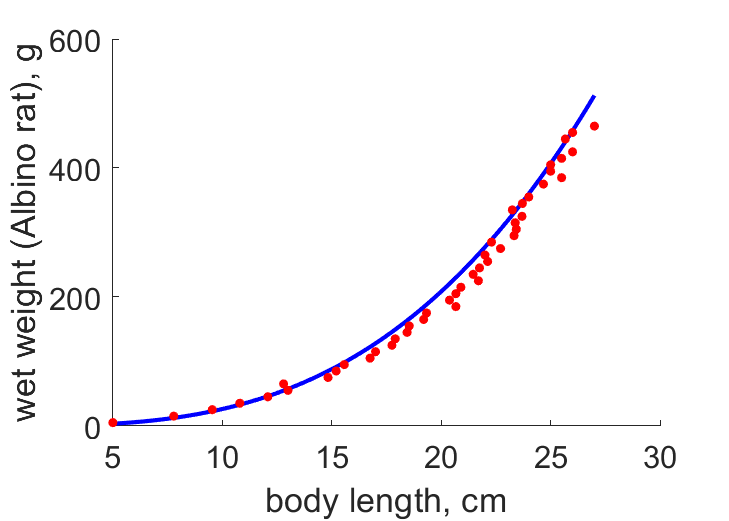 | body length | wet weight (Albino rat) | (0.07292) | DonaHata1911 |
| tL |  | age | Body-Length of Wistar | (0.01538) | GhezCamb2012 |
| tLe_f1_fast | 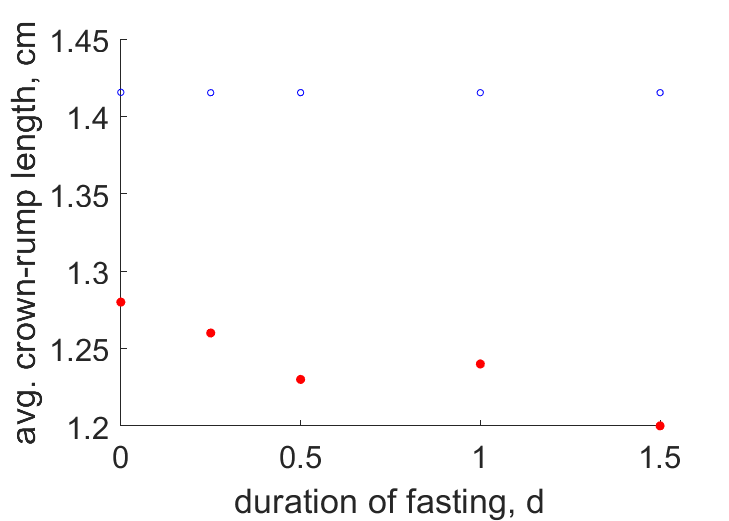 | duration of fasting | avg. crown-rump length | (0.6981) | Elli1980 |
| tWde | 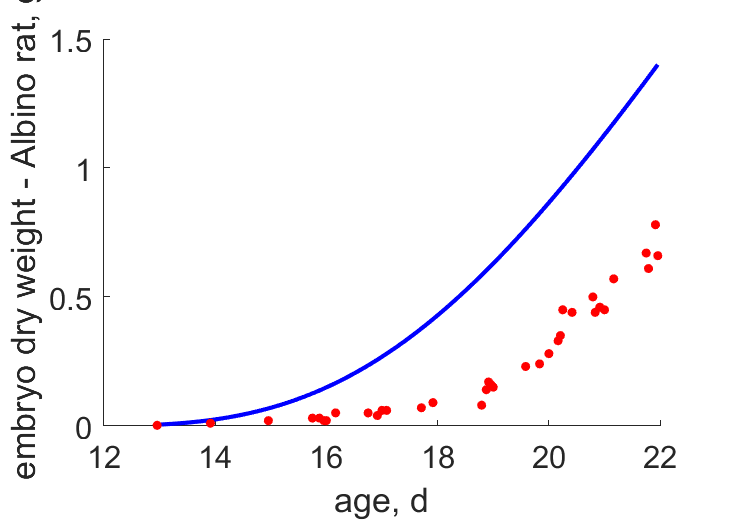 | age | embryo dry weight - Albino rat | (57.08) | Angu1932 |
| tWw | 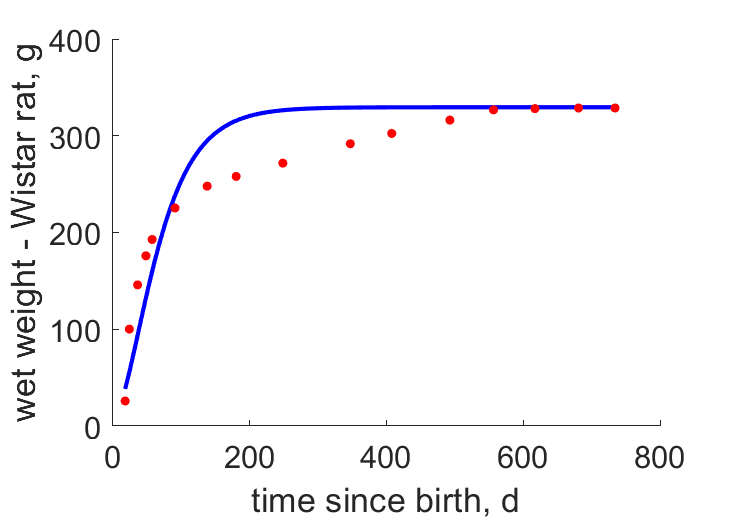 | time since birth | wet weight - Wistar rat | (0.1142) | RoeLee1995 |
| tWw_C |  | time since birth | wet weight - Wistar rat | (0.05032) | Baye2002a |
| tWw_f0_fast |  | duration of fasting | avg. loss of wet weight | (0.2323) | Elli1980 |
| tWwe |  | age | embryo wet weight - Albino rat | (0.1762) | Angu1932 |
Pseudo-data at Tref = 20°C
| Data | Generalised animal | Rattus norvegicus Wistar | Unit | Description |
|---|---|---|---|---|
| v | 0.02 | 0.02902 | cm/d | energy conductance |
| p_M | 18 | 4644 | J/d.cm^3 | vol-spec som maint |
| k_J | 0.002 | 0.002 | 1/d | maturity maint rate coefficient |
| k | 0.3 | 0.003378 | - | maintenance ratio |
| kap | 0.8 | 0.948 | - | allocation fraction to soma |
| kap_G | 0.8 | 0.8001 | - | growth efficiency |
| kap_R | 0.95 | 0.95 | - | reproduction efficiency |
Discussion
- Males are assumed to differ from females by {p_Am} and E_Hp only
- Contrary to the version 2018/06/18 >> Additional t-Ww, and t-JX (ingestion rate) and Ww-N data added. For simplicity, only mean data (of each study) uploaded for t-Ww and t-JX, but data are separated for males, pregnant females, and non-pregnant females. Wwb and Ri adjusted to match better observations (data).
- Parameters: [E_G] now higher but more in line with other rat entries. [p_M] higher (compared to prev.version and other rat entries), but possibly due to the fact that ingestion data has been added. Ingestion data could require a higher {p_Am} to match observed ingestion, but then a higher [p_M] to match observed size.Parameters d_X and mu_X were estimated because food energy content might differ from the default one (Kooijman 2010), and we assumed sufficient ingestion dataavailable for estimation. A default value for parameter d_V = 0.3 was used instead of the d_V = 0.13 in the previous version, because it is more realistic. As a consequence, data from Angu1932 were used as wet weight only, while dry weight was discarded for parameter estimation because it gives a d_V = 0.13.
- New function dget_EVH_AF developed with Dina Lika to calculate size and age at birth and weaning, and body mass and upregulation (of feeding) of mother during pregnancy and lactation, and growth of foetus/pup. See dget_EVH_AF for more info. Alternatively, length of the embryo can be calculated using the equation for exponential growth, while NOT using the dget_EVH_AF (as was done until now), if only embryonic phase is of interest. Predictions for embryo wet weight and dy weight (if calculated as now via get_EVH_AF.m) will very much depend on number of siblings in the litter and food ingestion of mother. Currently the predictions are an average of foetal growth in studies 2598 and 0392. Goodness of fit for foetal weight is slightly worse than in previous version possibly because dataset specific f was not used.
- All (adult) females are modelled with the new function, with non-pregnant females having the litter size of zero, and pregnant females the average litter size in that study.
- Currently the (measurable) growth of embryo starts after t_0, but this period between fertilization and growth is possibly used to prepare othermaternal and extra-embryonal structures. This is currently not modelled, but might be included in extensions, as the energy required for building thesetissues might explain the earlier (than predicted) onset of up-regulation of feeding. Alternatively, a different driver of earlier up-regulated feeding is possible, in which case t_0 is a diapause (reported for rats in literature.
- Kept from version 2018/06/18: All data present + specific function get_eL2 used for control males
- Modified version 2019/12/12: Used supply dynamics for embryo growth (instead of demand dynamics).Included additional data sets on the effect of reduced food availability on the weight of mothers and offspring.For these data sets on reduced food availability, functional reponses were calibrated to data of the mothers, and offspring was used as validation.
Acknowledgment
- Versions 2019/12/12 and 2022/06/10 of this entry were financially supported by Bayer.
Bibliography